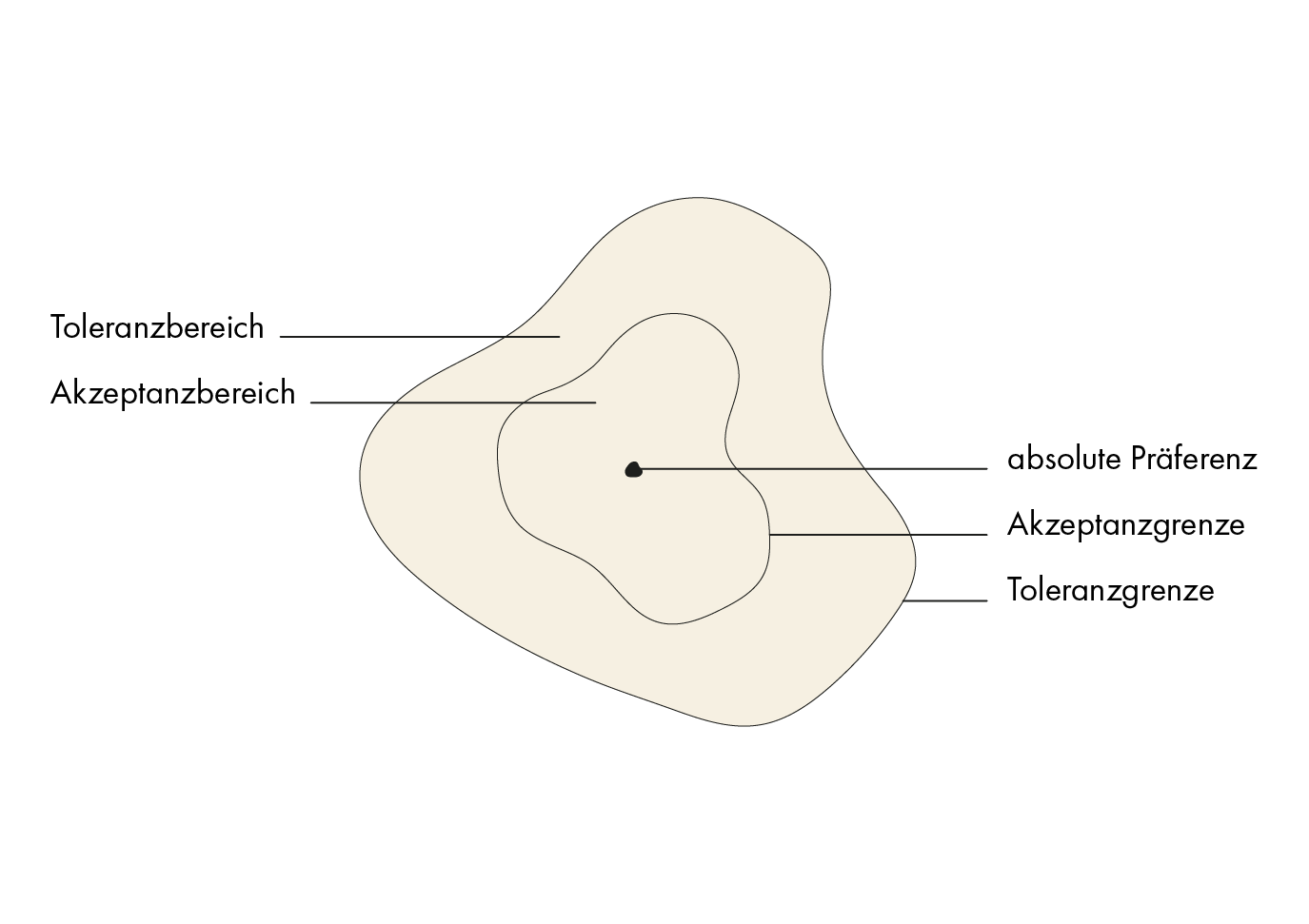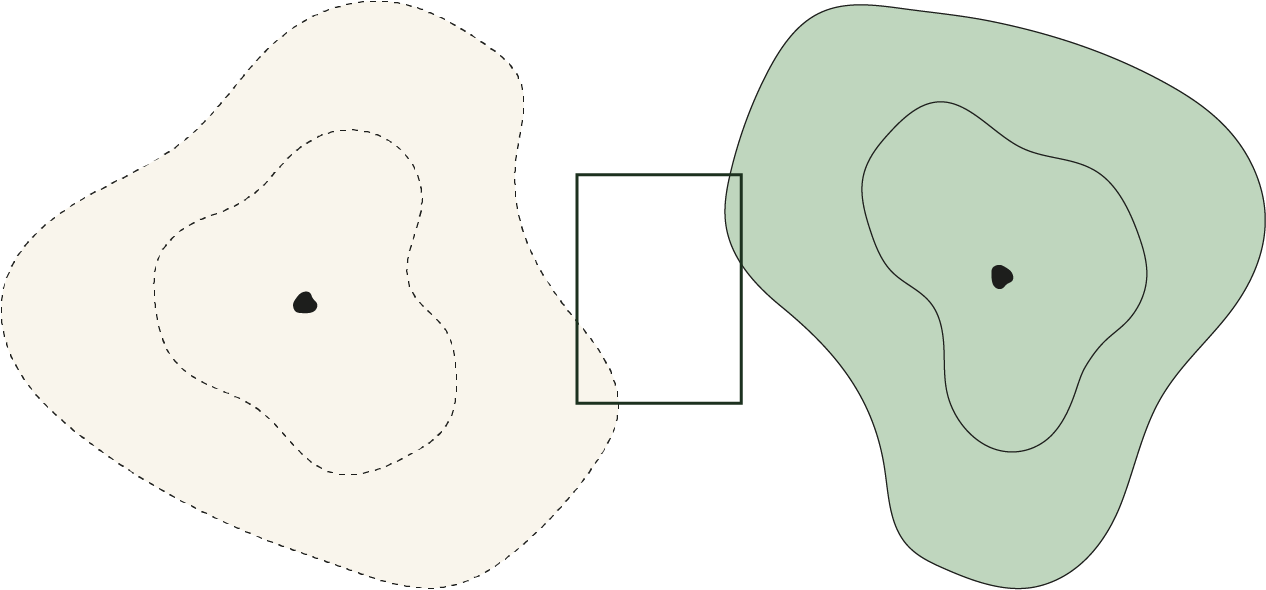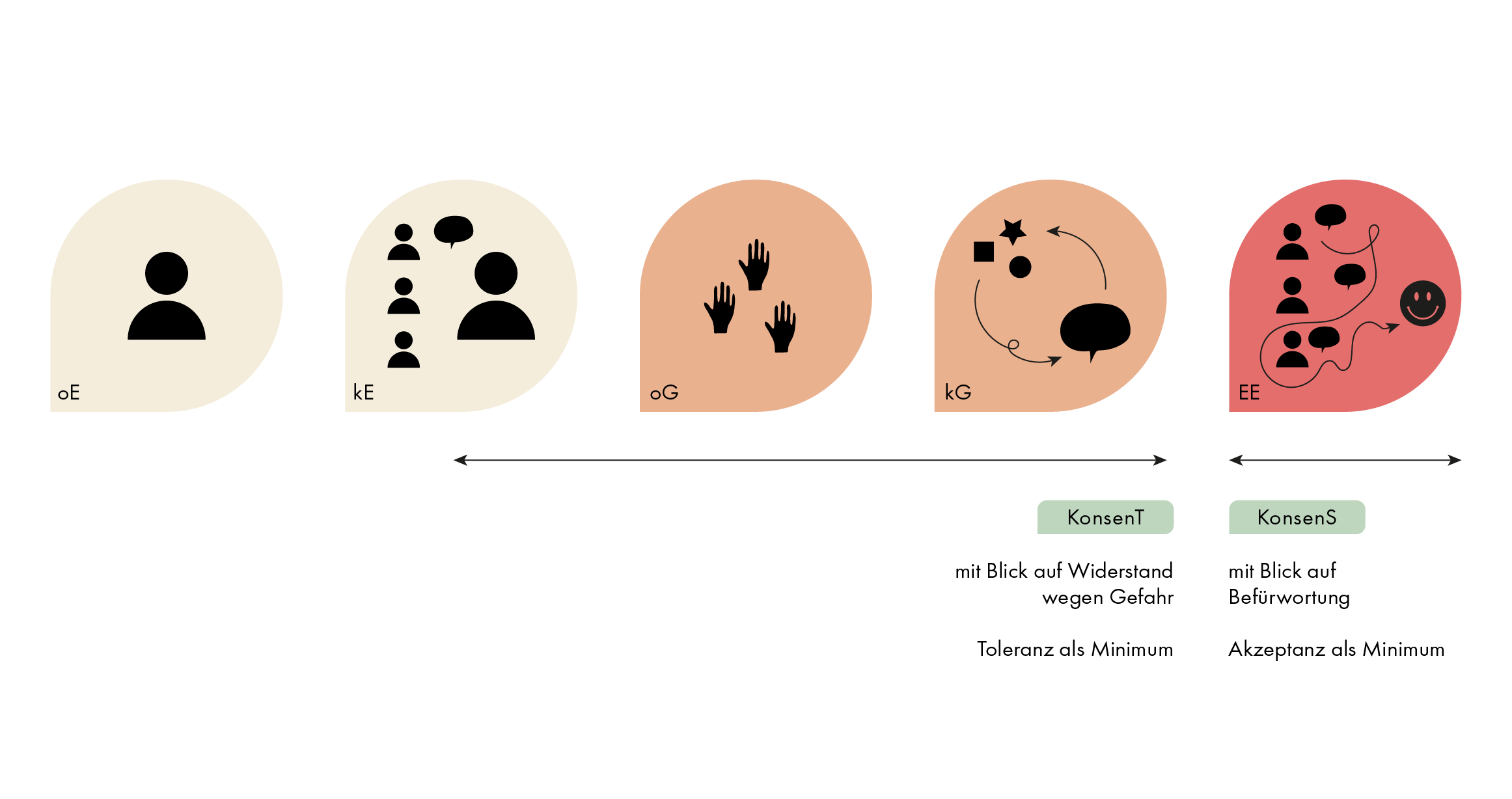
This diagram shows how the terms relate to each other.

At the core lies the absolute favourite alternative of the individual. Within the acceptance range the approval for all further options decreases more and more until the point is reached where an alternative is just acceptable. “Acceptance”, according to Günther Drosdowski, means something like accepting, consenting or putting up with. He adds an active component to the word, while tolerance is interpreted more as passive acquiescence.”[Wikipedia2023-1] Once this point is passed, further alternatives are merely tolerated. Within the tolerance range, a resistance builds up that keeps increasing until finally the point is reached where the alternative is no longer tolerable. From this point on, the persons raises a “grave objection” and exercises their veto.
We see below how this can be related for two persons who are both evaluating a particular alternative in the decision-making process:

Here no agreement is possible: The alternative lies clearly between the two persons, i.e. (partly) outside their respective tolerance ranges. Both will not vote for it or will rate it badly.

Here, both can “bear” it - the alternative is completely or largely within their respective tolerance ranges, but neither really likes it. This is the famous “lowest common denominator”, or basic consensus. Both rate this alternative with values from the tolerance range up to a maximum of abstention (acceptance threshold).

Now there is already partial acceptance of the alternative. Everyone has individual aspects that they find good. The common denominator of tolerance remains. We call it High ConsensusT. The score depends on how much the acceptance range overlaps with the alternative and how important the aspects of the alternative that lie within the individual’s acceptance range are to him. However, no one awards maximum points here.

Now the acceptance ranges overlap, i.e. there are aspects/features of the alternative that both people find good together. A (slight) agreement is reached (basic consensus). This is the prerequisite for jointly intrinsically motivated projects.

Now the alternative is completely within the acceptance range of both persons together. There are still different opinions about what would be the optimum (the two absolute preference points do not coincide), but almost all aspects are considered good by everyone. This is called “(overwhelming) unity” or High ConsensusS - this is the ideal to which one always strives. And it should have become clear why this is usually illusory - even with two people…

The “operational individual decision (oE) “ method often does not even seek consensus.
We make hundreds of decisions every day and it would be a miracle if every other person expressed their approval of the alternatives we have chosen.
Otherwise, there would only be one lunch dish for all people on the same day!
In reality, however, there will always be many people who don’t even consider my lunch tolerable, e.g. purely physically due to food intolerances.
But this is also the great advantage of the operational individual decision (oE): I determine the solution space solely through my personal tolerance range and choose the alternative that comes closest to my preference. This does not have to be easy at all, because it depends on the decision object. This is an area that is not the focus of DAD. You can look at here procedures for choosing what you personally think is the best alternative.
If the individual decides, but the framework is that he must have first consulted all those who are affected by his decision and all those who are knowledgeable about the decision object, then this corresponds to what is called “consultative individual decision (kE) “. It became known through the book “Reinventing Organisations” by Frederic Laloux [Laloux2015] and is the standard method for operational decisions in organisational models from the Teal concept. DAD calls it the “consultative single decision”. This procedure aims at a basic consensus as a maximum, since the tolerance ranges of the consulted persons are usually taken into account, but it does happen that people also disregard this. This procedure is also not the focus of DAD. You can read more about it here:
In group decision-making, at least the basic consensusT is expected and even more is sought. All those involved in the decision are heard and can usually raise their (serious) objections.
However, in the “operative group decision (oG) “ it is accepted that the decision lies outside the tolerance range of individuals. The goal here is therefore basic consensus.
Even in the “consultative group decision (kG) “ this can happen, but the requirement is at least the high consensus, even better a basic consensus.
This also depends on the concrete evaluation procedure. (more on this in the procedure overview).
But also apart from the chosen procedures remains: The more people are involved, the more likely it is that someone will actually not want to tolerate the chosen alternative.
And since the goal in kG is that this does not happen, evaluation procedures can also be chosen here that allow a single veto to prevent an alternative.
This is one of the distinguishing features between kG and oG.
And in the “unitary decision (EE) “ this point is compelling. Here the high consensus is always sought. Here, in the actual sense, it is no longer a question of a decision in which alternatives are evaluated and all “inferior” ones are cut away/sorted out, but rather one deliberates until an alternative is found that is within the range of acceptability for all. It is thus clear that this is the most lengthy and costly procedure and is usually only used for particularly important, critical decisions.